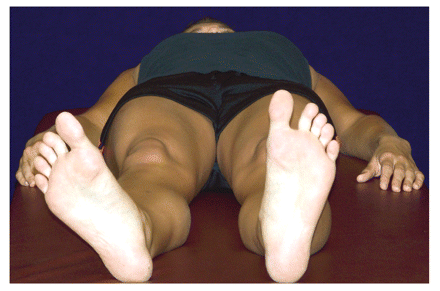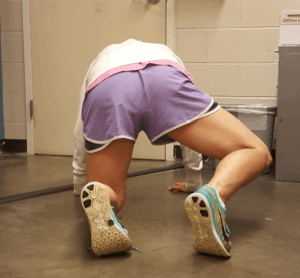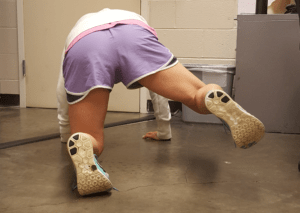
Hip External Rotation
featured photo credit: morphopedics.wikidot.com
Stiff hips cause pain, injury, and lackluster performance. A freely rotating hip is likely to flex, extend, abduct, and adduct with ease. Restrictions with any of these movements can often be traced back to restrictions in the rotation.
Clean up the rotation and you clean up everything. As internal rotation was touched upon in a previous post, the external rotation will be examined here, reflecting my current thoughts and theories regarding motor control and mobility.
For a long while, the clamshell has been the staple of practicing external rotation. Like most things, however, it’s not what you do but how you do it that really pokes at your understanding. A PRI clamshell feels very different than a traditional one performed with both feet on the floor. Most folks will use the knee not the glute to perform the movement.
The TFL on the outer thigh takes over, bullying his way into neurological favor. To minimize this character, pull the top leg into extension and then perform the movement. The glutes are a hip extender, so giving them a job they know how to do first puts them in a position to carry out the intended task:
Keeping your forearm on the floor minimizes thoracic cheating, and keeping the opposite hip flexed (knee up) keeps the lumbar spine from influencing the movement. Note how the heel stays down throughout.
External rotation can often get confused with abduction, or moving the leg laterally. While similar, the ankle and knee are not parallel to the ground in external rotation. You can think of abduction as a lateral lifting of the leg, and external rotation as a turning of the hip, irrelevant of whether or not the foot leaves the ground.
The ability to isolate these movements from one another can be used as an assessment of competency and control.
Working in the prone or face down position allows the pull of gravity to give the external rotators an accessible, consistent load in which to work against. The quadraped position (‘on-all-fours’, pictured above) differs from the ‘on-your-belly’ position in amount of limb contribution to the effort. Lying down requires a lot more core coordination to produce the movement, as you don’t have the pressing down of your hands and feet to help out. Trunk musculature, the very same that the hip muscles are a part of, is forced to engage in a novel and challenging way:
One of my favorite exercises for revealing true hip function. Foot lift = internal rotation, Knee lift = external rotation, leg lift = abduction. Keep the pubic bones on the floor, avoiding pelvic raise that can masquerade as external rotation.
This move is much harder than it seems. To regress, you can elevate the body by placing a pad underneath the hips (a less aBducted or aDducted knee requires less torque to get it off the ground). To progress, place the knee on an elevated surface and attempt to lift it off.
Straight-legged external rotation attempts to control a longer lever. Movement can be gauged by observing rotation (or lack of) happening at the knee. Ankle and foot pivoting often assists this motion, but a deliberate attempt to drive the action from the butt/ upper thigh tends to minimize this false positive.
I prefer using boxes to initially practice this movement over floor v-sits because an elevated ground is easier to push down upon. The extra support of the standing leg offers a positional advantage that allows the elevated leg to move more freely:
Similar to clamshells, starting in extension coaxes the external rotators into work mode.
The standing leg can also be manipulated into the external rotation:
Either leg in either position can be deemed ‘functional‘. Increasing ability in as many positions as possible should result in increased performance in a variety of situations, whether simulated or forced upon you by the environment. This clever move can show you a practical example more grounded in reality.
Once you have confidence in the slivers of movement, you can start blending them together to create your own instructional sequence:
Leaning the opposing knee in (internal rotation) creates ease in the working leg external rotation. Lifting the hands one at a time asks the core to pick up the slack the arms leave behind to keep the torso upright.
Use what you need to get joints there, then slowly remove the help and try to keep it there. The brain needs to know how to coordinate/sequence an action before it can do it instinctively. This process of giving assistance when needed and removing it when not is the most fulfilling aspect of learning and play. Experiment often. It greatly increases your chances of getting things right, and offers a constant opportunity for improvement.
TO REVIEW:
- Movement work is a personal endeavor of competency and control
- Understanding how you perform a movement is more important than knowing what movements you should perform
- Abduction is separate from external rotation
- Bent knee levers are shorter and require less torque to turn the leg
- Face down positioning utilizes gravity as a reactive aid to extend and externally rotate
- Extending before externally rotating pre-tensions the glutes
- Knee action serves as an observable biomarker to hip action
- Mobility work is mindful work
- Don’t be afraid to #makestuffup.






Hey again!
You said that if you “clean up rotation and you clean up everything”. Is this applicable to all joints or just hips? Could you possible expand on the why behind this?
Thanks!!
Hi 🙂 I do believe it’s true for all joints, even non-ball and sockets, like the wrist and neck. Like CARs, rotation gives you the broadest sense of ROM, and has a direct influence on flexion/ extension. Rotational adjustments during linear and lateral movements can also help you bypass pinch points.
Thanks for the response!
Got it. So, in essence doing a spine rotation stretch or hip internal and external rotation becomes a catch-all for those given joints? If you clear these, it may be unnecessary to work through flexion, extension, adduction, etc?
I wouldn’t go so far as to say that those other movements are unnecessary.. all movements are important. I think it could be better rephrased as, “rotation is a means to assist in improving flexion, extension, adduction, etc., other than treating these motions as isolated targets.”